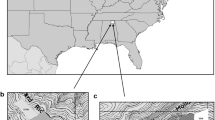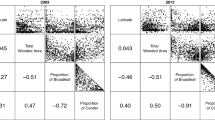Abstract
Context
Jack pine (Pinus banksiana)-dominated ecosystems of northern Lower Michigan are the primary breeding habitat for the federally endangered Kirtland’s warbler (Setophaga kirtlandii, KW). Historically, young stands used by KW were produced by stand-replacing wildfires, but fire suppression has necessitated the management of jack pine plantations for KW habitat since the 1970s. Effects of this long-term management on landscape age heterogeneity have previously not been quantified.
Objectives
We hypothesized that forest management has altered the spatial and temporal distribution of jack pine-dominated ecosystems beyond their historic range of variability.
Methods
By developing a diameter-age relationship for jack pine, we estimated ages of pre-European settlement trees found in General Land Office survey notes. We compared pre-European and current landscapes using geostatistical modeling of survey notes, and landscape metrics to quantify changes in pattern.
Results
Three KW management-based age classes (<20, 21–50, >50 years) are now more evenly distributed (31, 39, and 30 %, respectively) compared to the pre-European distribution (5, 19, 76 %) with little variability over time. Landscape metrics suggest the current landscape is younger and more fragmented than the pre-European landscape. These changes indicate restriction of the historic range of age variability, largely due to conversion of older jack pine stands to young KW habitat plantations.
Conclusions
Management has met KW population objectives, but has altered the temporal variability of the landscape’s age structure. Pre-European settlement patterns of stand-ages may provide a foundation for an ecosystem-based management plan for the region that supports both KW and the ecosystems upon which they depend.





Similar content being viewed by others
References
Albert DA (1995) Regional landscape ecosystems of Michigan, Minnesota and Wisconsin: a working map and classification. General Technical Report NC-178. St. Paul, MN: UDSA-FS, North Central Forest Experiment Station
Austin MB, Leibfried TR, Korroch KM (1999) Land use circa 1800 [Digital map]. Michigan Natural Features Inventory, Lansing
Baker WL (1992) Effects of settlement and fire suppression on landscape structure. Ecology 73:1879–1887
Bocetti CI, Goble DD, Scott JM (2012) Using conservation management agreements to secure post-recovery perpetuation of conservation-reliant species: the Kirtland’s Warbler as a case study. BioScience 62:874–879
Bonham-Carter GF (2014) Geographic information systems for geoscientists: modelling with GIS. Elsevier Science, Amsterdam
Burns RM, Honkala BH (1990) Silvics of North America. Department of Agriculture, Forest Service, U.S. G.P.O, Washington
Churchill DJ, Larson AJ, Dahlgreen MC, Franklin JF, Hessburg PF, Lutz JA (2013) Restoring forest resilience: from reference spatial patterns to silvicultural prescriptions and monitoring. For Ecol Manag 291:442–457
Cleland DT, Crow TR, Saunders SC, Dickmann DI, Maclean AL, Jordan JK, Watson RL, Sloan AM, Brosofske KD (2004) Characterizing historical and modern fire regimes in Michigan (USA): a landscape ecosystem approach. Landscape Ecol 19:311–325
Comer PJ, Albert DA, Corner RA, Wells HA, Hart BL, Raab JB, Price DL, Kashian DM (1995) Michigan’s presettlement vegetation, as interpreted from the General Land Office surveys 1816–1856. Michigan Natural Features Inventory, Lansing. Digital map
Corace RG III, Goebel PC (2010) An ecological approach to forest management for wildlife: integrating disturbance ecology patterns into silvicultural treatments. Wildl Profess Spring, pp 38–40
Corace RG III, Korte JL, Shartell LM, Kashian DM (2016) Upland sandpiper: a flagship for jack pine barrens restoration in the upper Midwest? Ecol Restor 34:1
Corace RG III, Seefelt NE, Goebel PC, Shaw HL (2010) Snag longevity and decay class development in a recent jack pine clearcut in Michigan. North J Appl For 27:125–131
Cullinane-Anthony BL, Seefelt NE, Corace RG III, Kashian DM, Gehring TM (2014) Influence of residual forest patches on post-fire bird diversity patterns in jack pine-dominated ecosystems of northern Lower Michigan. For Ecol Manag 331:93–103
Cyr D, Gauthier S, Bergeron Y, Carcaillet C (2009) Forest management is driving the eastern North American boreal forest outside its natural range of variability. Front Ecol Environ 7:519–524
Donner DM, Probst JR, Ribic CA (2008) Influence of habitat amount, arrangement, and use on population trend estimates of male Kirtland’s warblers. Landscape Ecol 23:467–480
Doremus H, Pagel JE (2001) Why listing may be forever: perspectives on delisting under the U.S. endangered species act. Conserv Biol 15:1258–1268
ESRI (2011) ArcGIS desktop: release 10.2. Environmental Systems Research Institute, Redlands
Franklin JF (1993) Preserving biodiversity: species, ecosystems, or landscapes? Ecol Appl 3:202–205
Grumbine RE (1994) What is ecosystem management? Conserv Biol 8:27–38
Handler S, Duveneck MJ, Iverson L, Peters E, Scheller RM, Wythers KR, Brandt L, Butler P, Janowiak M, Shannon PD, Swanston C (2014) Michigan forest ecosystem vulnerability assessment and synthesis: a report from the Northwoods Climate Change Response Framework project. Gen. Tech. Rep. NRS-129. Newtown Square, PA: U.S. Department of Agriculture, Forest Service, Northern Research Station
Hessburg PF, Smith BG, Salter RB (1999) Detecting change in forest spatial patterns from reference conditions. Ecol Appl 9:1232–1252
Holling CS, Meffe GK (1996) Command and control and the pathology of natural resource management. Conserv Biol 10:328–337
IBM Corp. Released 2013. IBM SPSS Statistics for Windows, Version 22.0. Armonk, NY: IBM Corporation
Kashian DM, Barnes BV, Walker WS (2003a) Landscape ecosystems of northern Lower Michigan and the occurrence and management of the Kirtland’s warbler. For Sci 49:140–159
Kashian DM, Barnes BV, Walker WS (2003b) Ecological species groups of landform-level ecosystems dominated by jack pine in northern Lower Michigan, USA. Plant Ecol 166:75–91
Kashian DM, Corace RG III, Shartell LM, Donner DM, Huber PW (2012) Variability and persistence of post-fire biological legacies in jack pine-dominated ecosystems of northern Lower Michigan. For Ecol Manag 263:148–158
Keane RE, Hessburg PF, Landres PB, Swanson FJ (2009) The use of historical range and variability (HRV) in landscape management. For Ecol Manag 258:1025–1037
Kenkel NC, Hendrie ML, Bella IE (1997) A long-term study of Pinus banksiana population dynamics. J Veg Sci 8:241–254
Krivoruchko K (2012) Empirical Bayesian Kriging implemented in arc GIS geostatistical analyst. Arc User 15:6–10
Landis JR, Koch GG (1977) The measurement of observer agreement for categorical data. Biometrics 33:159–174
Landres PB, Morgan P, Swanson FJ (1999) Overview of the use of natural variability concepts in managing ecological systems. Ecol Appl 9:1179–1188
Leahy MJ, Pregitzer KS (2003) A comparison of presettlement and present-day forests in northeastern Lower Michigan. Am Midl Nat 149:71–89
LeDuc SD, Rothstein DE (2010) Plant-available organic and mineral nitrogen shift in dominance with forest stand age. Ecology 91:708–720
Lindenmayer DB, Margules CR, Botkin DB (2000) Indicators of biodiversity for ecologically sustainable forest management. Conserv Biol 14:941–950
Liu F, Mladenoff DJ, Keuler NS, Moore LS (2011) Broadscale variability in tree data of the historical Public Land Survey and its consequences for ecological studies. Ecol Monogr 81:259–275
Maclean AL, Cleland DT (2003) Determining the spatial extent of historical fires with geostatistics in northern Lower Michigan. In: Fire, fuel treatments, and ecological restoration. Conference proceedings, pp 16–18
Manies KL, Mladenoff DJ, Nordheim EV (2001) Assessing large-scale surveyor variability in the historic forest data of the original U.S. Public Land Survey. Can J For Res 31:1719–1730
McGarigal K, Cushman SA, Neel MC, Ene E (2002) FRAGSTATS v3: computer software program produced by the authors at the University of Massachusetts, Amherst. http://www.umass.edu/landeco/research/fragstats/fragstats.html
Michigan Department of Natural Resources, U.S. Fish and Wildlife Service, U.S. Forest Service (2015) Kirtland’s Warbler breeding range conservation plan. MI DNR, Lansing
Millar CI, Stephenson NL, Stephens SL (2007) Climate change and forests of the future: managing in the face of uncertainty. Ecol Appl 17:2145–2151
Moritz MA, Batllori E, Bradstock RA, Gill AM, Handmer J, Hessburg PF, Leonard J, McCaffrey S, Odion DC, Schoennagel T, Syphard AD (2014) Learning to coexist with wildfire. Nature 515:58–66
Petraitis PS, Latham RE, Niesenbaum RA (1989) The maintenance of species diversity by disturbance. Q Rev Biol 64:393–418
Probst JR, Weinrich J (1993) Relating Kirtland’s warbler population to changing landscape composition and structure. Landscape Ecol 8:257–271
R Core Team R: a language and environment for statistical computing. Austria. https://cran.r-project.org/
Rothstein DE, Yermakov Z, Buell AL (2004) Loss and recovery of ecosystem carbon pools following stand-replacing wildfire in Michigan jack pine forests. Can J For Res 34:1908–1918
Schulte LA, Mladenoff DJ (2001) The original US public land survey records: their use and limitations in reconstructing presettlement vegetation. J For 99:5–10
Schwartz MW (2008) The performance of the endangered species act. Annu Rev Ecol Evol Syst 39:279–299
Scott JM, Goble DD, Haines AM, Wiens JA, Neel MC (2010) Conservation-reliant species and the future of conservation. Conserv Lett 3:91–97
Seidl R, Rammer W, Spies TA (2014) Disturbance legacies increase the resilience of forest ecosystem structure, composition, and functioning. Ecol Appl 24:2063–2077
Simard AJ, Blank RW (1982) Fire history of a Michigan jack pine forest. Mich Acad 15:59–71
Simberloff D (1998) Flagships, umbrellas, and keystones: is single-species management passé in the landscape era? Biol Conserv 83:247–257
Spaulding SE, Rothstein DE (2009) How well does Kirtland’s warbler management emulate the effects of natural disturbance on stand structure in Michigan jack pine forests? For Ecol Manag 258:2609–2618
Stokstad E (2005) What’s wrong with the endangered species act? Science 309:2150–2152
Walkinshaw LH (1983) Kirtland’s warbler: the natural history of an endangered species. Cranbrook Institute of Science, Bloomfield Hills
White MA, Host GE (2008) Forest disturbance frequency and patch structure from pre-European settlement to present in the Mixed Forest Province of Minnesota, USA. Can J For Res 38:2212–2226
White PS, Walker JL (1997) Approximating nature’s variation: selecting and using reference information in restoration ecology. Restor Ecol 5:338–349
Whitlock MC, Schluter D (2009) The analysis of biological data. Roberts and Company, Greenwood Village
Whitney GG (1987) An ecological history of the Great Lakes forest of Michigan. J Ecol 75:667–684
Williams MA, Baker WL (2011) Testing the accuracy of new methods for reconstructing historical structure of forest landscapes using GLO survey data. Ecol Monogr 81:63–88
Acknowledgments
We wish to acknowledge the assistance of several people instrumental in procuring data for this research: T. Greco, Michigan Department of Natural Resources; P. Huber and L. McNichols, US Forest Service; D. Rothstein, Michigan State University; and E. Schools, Michigan Natural Features Inventory. We also thank the Kirtland’s Warbler Recovery Team for helpful feedback. T. Dowling, D.R. Kashian, D. Rothstein, and two anonymous reviewers made helpful comments on earlier versions of this manuscript, and P. Huber and S. Sjogren provided constructive feedback in the earliest stages of this study. This project was funded with a grant from the Joint Fire Science Program to R.G.C. III and D.M.K. The findings and conclusions of this article are those of the authors and do not necessarily represent the views of the U. S. Fish and Wildlife Service or other agencies and institutions.
Author information
Authors and Affiliations
Corresponding author
Rights and permissions
About this article
Cite this article
Tucker, M.M., Corace, R.G., Cleland, D.T. et al. Long-term effects of managing for an endangered songbird on the heterogeneity of a fire-prone landscape. Landscape Ecol 31, 2445–2458 (2016). https://doi.org/10.1007/s10980-016-0413-7
Received:
Accepted:
Published:
Issue Date:
DOI: https://doi.org/10.1007/s10980-016-0413-7




